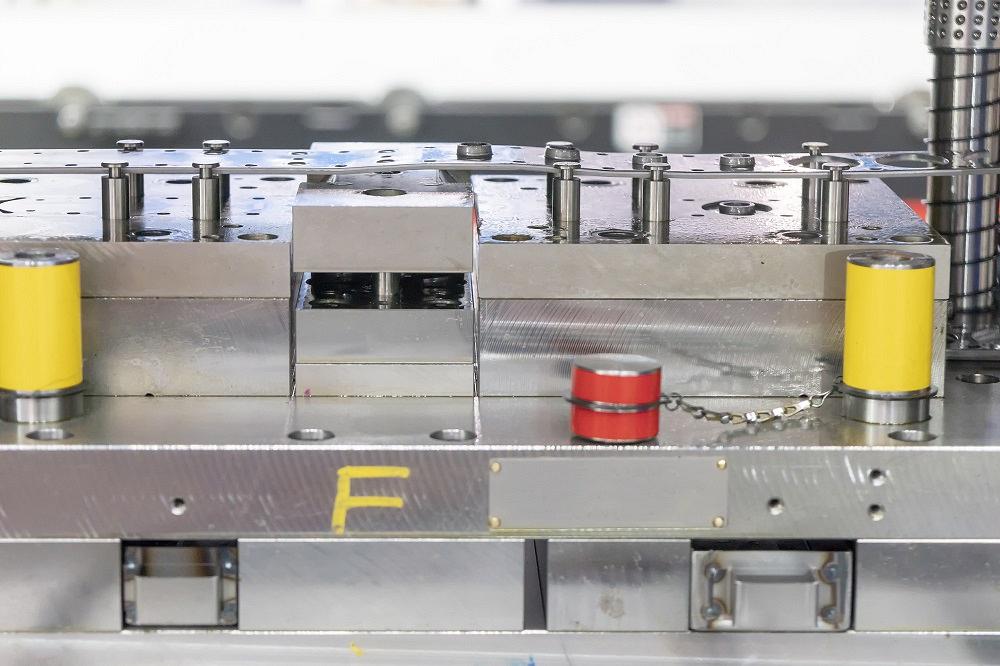Contributing Writer
- FMA
- The Fabricator
- FABTECH
- Canadian Metalworking
Categories
- Additive Manufacturing
- Aluminum Welding
- Arc Welding
- Assembly and Joining
- Automation and Robotics
- Bending and Forming
- Consumables
- Cutting and Weld Prep
- Electric Vehicles
- En Español
- Finishing
- Hydroforming
- Laser Cutting
- Laser Welding
- Machining
- Manufacturing Software
- Materials Handling
- Metals/Materials
- Oxyfuel Cutting
- Plasma Cutting
- Power Tools
- Punching and Other Holemaking
- Roll Forming
- Safety
- Sawing
- Shearing
- Shop Management
- Testing and Measuring
- Tube and Pipe Fabrication
- Tube and Pipe Production
- Waterjet Cutting
Industry Directory
Webcasts
Podcasts
FAB 40
Advertise
Subscribe
Account Login
Search
Die Science: Tips for preventing stamping die crashes
Downtime and cost can be disastrous to any stamping operation
- By Art Hedrick
- April 9, 2020
- Article
- Bending and Forming

Die crashes can be disastrous to a stamping shop in terms of downtime and cost. Art Hedrick presents several tips for reducing the chance of a stamping die catastrophe. Getty Images
During a recent phone conversation about a training outline, a client abruptly ended our call with this statement: “Hey, Art, I just got paged to the press on an urgent matter, most likely a die crash. Can I call you back later?”
It’s not the first time that a project has been disrupted. On several occasions while presenting a stamping-related course, I have had attendees leave the session to address a die crash crisis. And it is a crisis. A severe die crash can cripple a stamping company. In some cases, the die or the tool may have to be completely rebuilt or even replaced, which can take from several days to several months to complete. And if you want to expedite that process, it will cost you two to three times the original tool price, because the die building shop will have to stop all work on other projects to focus entirely on replacing the damaged die.
Needless to say, a series of catastrophic die crashes can financially destroy a company. So what causes die crashes, and how can we prevent them?
Material Feed Problems
Statistically speaking, more damage is done to a progressive die in the first 10 strokes of the press than during production. As the strip starts, there typically are unbalanced forces in the die. Unbalanced cutting or forming can cause the upper and lower dies to misalign and shear, resulting in die damage.
In addition, incorrect starting of the material can leave loose scrap in the die, which can cause double metal to be fed into the tool, potentially causing severe die damage. A good die designer will establish a distinct first-hit line by placing a positive spring-loaded stop at this point, rather than a simple line with a “start strip here” notation.
To prevent these damaging feed problems, double-check the following during setup:
- The die is set up parallel to the coil feeder. To do this, install two solid pins on the bolster or bed of the press that are parallel with the coil feeder. Two machined surfaces (parallel to the pilots) are pushed up against these pins, aligning the die parallel to the coil feeder.
- All bolts securing the die in the press are tightened.
- The guide pins are engaged as much as possible before the die is clamped in the press, within 0.062 inch of the stop blocks.
- Feed pitch and progression are set correctly. Overfeeding or underfeeding most likely will result in a misfeed and die damage.
- Pilot or feed release is set correctly. Gripping the strip with feed rollers while trying to locate the strip with pilot pins will most likely result in mislocating or feeding problems.
- Die location is correct in the press. Whenever possible, try to balance the force within the ram and bolster plate of the press. Keep in mind that the center or the middle of the die is not always the centerline of the tonnage or force. Avoid having any portion of the die hanging outside the ram and bolster area of the press, especially if work is being performed in these areas. It can cause leverage that results in a loss of ram-to-bolster parallelism.
- The trailing edge of the strip is not run through the die. If it is, the result can be half-cuts and half-forms, which in turn can damage tooling.
- Press shut height is correct. If it’s too low, the die will be crushed by the force of the press.
- No loose scrap is evident, especially when first starting the strip.
- All slug drop areas are free from interference, and scrap falls freely from the tool.
- All die-protection sensors are working properly.
- The material is free from edge camber that could impede feeding ability.
Preventing Die Crashes by Design
Die designers must pay special attention to several important factors during die design:
- When designing progressive dies, use pad balancers to prevent each pressure pad from tipping when the strip is not fully loaded into the die.
- Provide adequate die protection, such as proximity switches and metal sensors.
- Heel the die properly to adsorb excessive side thrust that may be generated during cutting and forming.
- Put large leads on rails for ease of stock entry.
- Support the carrier strip adequately throughout the entire tool.
- Whenever permissible, use a pitch stop to control pitch and create a straight coil edge for smooth feeding.
The Human Factor
Even if you have implemented a sophisticated die-protection system, nothing can take the place of a well-educated operator. Make sure your press operators understand the fundamentals of dies and presses. They should know how the press works and what to look for in each die type.
Make sure they carefully monitor scrap removal and part ejection. A drawn panel stuck in the top half of the die looks similar to the die cavity. Operators need to look for the blank edges and make sure that a part is not stuck in the top. They also need to monitor die sensors and understand when the sensors are at fault, or when the problem is with the die.
Give operators ownership in the tool. It’s a well-known fact that people will take more pride in their work if they are included in the process. Ask how they would improve operations they’re responsible for. People will support a world they are allowed to create, so if possible, invite them to a meeting when the die is being designed and allow them to give feedback. And give them credit or rewards for good, effective ideas. A simple thank you can go a long way.
Die crashes have numerous causes, far more than discussed here. In my nearly 40 years in the tooling and stamping trade, I’ve learned that success is a combination of technology, design, education, and people. Having the right people and creating an environment that supports enthusiasm, creativity, happiness, self-worth, pride, and ownership are key.
About the Author

Art Hedrick
10855 Simpson Drive West Private
Greenville, MI 48838
616-894-6855
Related Companies
subscribe now

The Fabricator is North America's leading magazine for the metal forming and fabricating industry. The magazine delivers the news, technical articles, and case histories that enable fabricators to do their jobs more efficiently. The Fabricator has served the industry since 1970.
start your free subscription- Stay connected from anywhere

Easily access valuable industry resources now with full access to the digital edition of The Fabricator.

Easily access valuable industry resources now with full access to the digital edition of The Welder.

Easily access valuable industry resources now with full access to the digital edition of The Tube and Pipe Journal.
- Podcasting
- Podcast:
- The Fabricator Podcast
- Published:
- 04/30/2024
- Running Time:
- 53:00
Seth Feldman of Iowa-based Wertzbaugher Services joins The Fabricator Podcast to offer his take as a Gen Zer...
- Industry Events
Pipe and Tube Conference
- May 21 - 22, 2024
- Omaha, NE
World-Class Roll Forming Workshop
- June 5 - 6, 2024
- Louisville, KY
Advanced Laser Application Workshop
- June 25 - 27, 2024
- Novi, MI
Precision Press Brake Certificate Course
- July 31 - August 1, 2024
- Elgin,
































